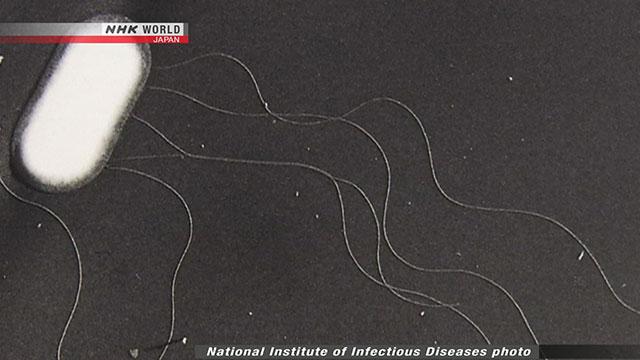Last month, over 20 people fell ill after eating prepared dishes, including potato salad, sold at 4 outlets of a deli chain in Gunma and Saitama prefectures, north of Tokyo.
The city of Maebashi in Gunma said the girl who died ate food from one of the outlets. Municipal and health ministry officials said she was admitted to a hospital in Tokyo after complaining of health problems on August 11th, but passed away earlier this month.
As of Wednesday, 22 people who ate the deli food were confirmed to have been infected with E. coli O157.
Route of infection remains a mystery
The National Institute of Infectious Diseases has examined samples collected from those who became infected with the O157 bacteria after eating food bought at the deli chain. It says the E. coli strain found in all of the patients were genetically identical.
But the route of infection remains a mystery. The authorities did not find O157 bacteria in samples of potato salad left at the food plant, its cooking equipment, nor in employees' stool samples. They were unable to confirm if the food was laced with the bacteria at the plant or not.
The authorities also did not detect the bacteria in utensils and employees' stools at the deli in Maebashi. The outlet served the food in large plates without lids. Customers would use the same pair of tongs to pick food from different plates.
Health ministry officials say the same type of E. coli has been detected in other food-poisoning cases in the Kanto Region and other parts of Japan. They plan to clarify the infection route by studying what the patients ate and where they had been before suffering symptoms.
The E. coli outbreak began on August 21st
O157 bacteria were detected in a 5-year-old girl who ate potato salad purchased at an outlet of the "Delicious" deli chain in Kumagaya city, Saitama Prefecture. The girl fell unconscious at one point.
Gradually, more people started to show symptoms. On Wednesday, O157 bacteria were detected in 20 people who bought food at 4 of the chain's outlets in Saitama and Gunma prefectures.
The food-poisoning cases prompted authorities to suspend business at 2 of the outlets. The operator of the deli chain closed the 2 outlets, as well as the other 15 outlets in the Kanto Region from August 24th. But it reopened them on September 7th after taking measures to improve hygiene.
Later in the day, it was revealed that the 3-year-old girl from Tokyo died from O157 after eating food bought at the outlet in Maebashi city.
Another case was confirmed shortly after, bringing the number of people infected through the deli chain to 22.
Past O157 infections and precautions
O157 is an enterohemorrhagic strain of E. coli. The bacteria are mainly found in the intestines of cows, sheep and other livestock.
It is highly infectious, and a minute amount of the bacteria can cause symptoms. People get infected by ingesting tainted water or food.
The bacteria have an incubation period of about one week, and after that, those infected experience symptoms including severe abdominal pain, fever, and bloody feces.
Patients usually recover after about 2 weeks. But about 7 percent of them develop hemolytic-uremic syndrome due to poison released by the bacteria. The condition's symptoms include encephalopathy, impaired consciousness, and kidney failure, and can be fatal.
In Japan, about 3,000 to 4,000 O157 infections are reported every year. About 10 of those infected, mainly elderly people, die as a result.
In 1996, 3 children died within 6 months in an outbreak at an elementary school in Sakai City, Osaka. More than 9,500 people were infected, causing widespread concern.
There have been more O157 food-poisoning cases since then. In 2012, 169 people were infected with the bacteria after eating pickles made at a food company in Sapporo city, Hokkaido. The incident left 8 people dead.
Last year, 10 people died at elderly care facilities in Hamura city in Tokyo and Ichikawa city in Chiba Prefecture after being infected with O157 bacteria.
This year, 5 elderly people died in Sapporo -- 3 at a hospital and 2 at an elderly-care facility. Facilities for the elderly in Gunma and Osaka have also reported deaths from O157 infections.
Expert warns on O157 symptoms
She pointed out that the girl who died lived in Tokyo and ate the food in question during summer break, when people travel frequently. She says that's likely to be one of the reasons why it took so long to link her death to the recent food-poisoning cases.
Nakamura says businesses that offer take-out food should make sure that each customer will use a different pair of tongs. She also says they should offer packaged food, especially in the summer.
She says consumers should bear in mind that most food items are not bacteria-free. She also recommends that consumers swiftly put purchased food into the refrigerator when they get home and eat it as soon as possible.
Nakamura says O157 infections can lead to grave after-effects. She says children and the elderly are especially likely to become seriously ill, and says people should consult a doctor if they develop diarrhea or other symptoms.
